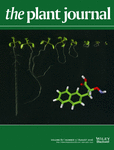Journal list menu
Export Citations
Download PDFs
Issue Information
FEATURED ARTICLE (RESOURCE)
Aminooxy-naphthylpropionic acid and its derivatives are inhibitors of auxin biosynthesis targeting l-tryptophan aminotransferase: structure–activity relationships
- Pages: 245-257
- First Published: 04 May 2016
It is difficult to evaluate the functions of auxin and the biosynthesis pathways of indole-3-acetic acid using genetic approaches; chemical genetics is an alternative method. Here we show that L-α-aminooxy-phenylpropionic acid (AOPP), an inhibitor of auxin biosynthesis, targets tryptophan aminotransferase. We synthesized novel compounds derived from AOPP to study the structure–activity relationships of inhibitors of tryptophan aminotransferase in vitro, and identified some that were more potent, and more specific, in inhibiting auxin levels. We designate these compounds ‘pyruvamines’.
ORIGINAL ARTICLES
Root-specific expression of opine genes and opine accumulation in some cultivars of the naturally occurring genetically modified organism Nicotiana tabacum
- Pages: 258-269
- First Published: 28 April 2016
Several naturally occurring GMO plants have been described, belonging to the genera Nicotiana, Linaria and Ipomoea, several carry opine synthesis genes. Sofar, however, detectable levels of opines have not been demonstrated in such natural GMOs. We find that the cT-DNA TB-mas2’ gene is expressed at very low levels in most Nicotiana tabacum cultivars. However, in some cultivars TB-mas2’ is highly expressed in root tips giving detectable levels of the Amadori opine deoxyfructosyl-glutamine.
Transfer RNA maturation in Chlamydomonas mitochondria, chloroplast and the nucleus by a single RNase P protein
- Pages: 270-280
- First Published: 01 May 2016
RNase P removes 5′ leader sequences of tRNA precursors. Here we demonstrate that Chlamydomonas has a single RNase P gene whose gene product acts in the chloroplast, mitochondria and the nucleus, thus contradicting the dogma that different RNase P systems act in each of these cellular compartments.
Diverse pathways of phosphatidylcholine biosynthesis in algae as estimated by labeling studies and genomic sequence analysis
- Pages: 281-292
- First Published: 01 May 2016
Phosphatidylcholine (PC) is nearly ubiquitous in eukaryotic algae and plants, but Chlamydomonas reinhardtii does not synthesize PC. Here we used comparative genomic analysis and radiolabeling to demonstrate the diversity of PC biosynthetic pathways in other Chlamydomonas species and in red algae. Our results suggest parallel losses of enzymes in some lineages.
Evolutionary trajectory of phytoalexin biosynthetic gene clusters in rice
- Pages: 293-304
- First Published: 01 May 2016
In plants, pathways for specialized metabolites are sometimes encoded by operon-like gene clusters. Here were use comparative genomics and biochemical studies in rice species to provide an evolutionary insight the mechanisms of formation of gene clusters encoding diterpene phytoalexins.
Imprinted gene OsFIE1 modulates rice seed development by influencing nutrient metabolism and modifying genome H3K27me3
- Pages: 305-317
- First Published: 01 May 2016
Imprinted Polycomb group genes play a critical role in seed development in Arabidopsis, but the roles of imprinted genes in cereals remain obscure. Here, we characterize a rice endosperm-specific Polycomb group gene OsFIE1, which influences transcription factor expression and nutrient metabolism in rice.
RESOURCE
System level analysis of cacao seed ripening reveals a sequential interplay of primary and secondary metabolism leading to polyphenol accumulation and preparation of stress resistance
- Pages: 318-332
- First Published: 02 May 2016
Cacao and its popular product, chocolate, have potential health benefits, with metabolites with anti-oxidant and anti-depressant effects, and which inhibit platelet aggregation and obesity-dependent insulin resistance. Here we used proteomics and metabolomics to investigate cacao seed ripening and thus elucidate the underlying developmental controls of these biochemical processes.




